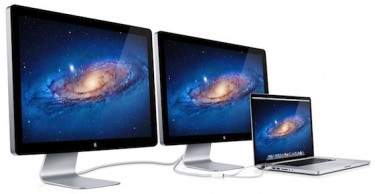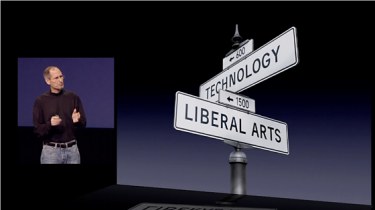 Back to selection
Back to selection
FCP X: More Musings
Since Aesop the fable has been told of the snake or scorpion whose life is being saved by a farmer, turtle, or frog, and who then turns around and inflicts a mortal bite or sting upon its benefactor, perforce sealing its own fate too. The point of the fable is not that snakes or scorpions are evil, but that we each possess an essential nature that drives our behavior, and that others ignore our essential nature at their peril.
Hold on to that thought. We’ll come back to it.
Since posting my initial notes on FCP X, FIRST MUSINGS, the tsunami of hand wringing and head scratching triggered by Apple’s June 21st debut of FCP X has intensified, even gaining cultural cachet. Absurdly enough, this tempest in a timeline was parodied in a sketch on Conan O’Brien’s new TBS chat show. (Is late night comedy that desperate?)
If, like me, you’ve been too preoccupied with shoots and deadlines and countless demands of real life, and have not found time to track every Internet forum exchange or jeremiad against Apple for having abandoned professional editing, you may have missed some of the more thoughtful commentaries that have surfaced in the month since FCP X superseded FCP 7.
Chief among them is Gary Adcock’s Creative Cow series. Part One of his FCP X review, MetaData and Media Management, explains that while the first release of FCP X may lack bells and whistles critical to pro FCP editors and today’s postproduction workflow, just give it some time.
What’s available now, he says, is blazing 64-bit speed, a seemingly renderless timeline, the ability to instantly edit files even while you’re ingesting them, and a new type of media management orders of magnitude beyond anything in FCP 7. New media management tools include keywords (auto or manually assigned) and a built-in database to sort them along with myriad other types of metadata. For the timeline itself, Apple has forever eliminated the possibility of sync issues with a new method of linking of associated video and audio clips (“clip connections” and “magnetic timeline”).
Part Two, Hardware Changes, illuminates a technology leap: FCP X not only takes advantage of each core in every available multi-core processor, it also harnesses each GPU (graphics processing unit) on every available graphics card. This is the promise of distributed processing fulfilled at last, and explains how FCP X gleans unused CPU and GPU cycles to render continuously and imperceptibly in the background.
Gary uses a brilliant puppeteer-marionette metaphor to illustrate the challenges of replacing the aging 32-bit QuickTime with a more modern and advanced media framework, AV Foundation, borrowed from iOS development (iPhone and iPad operating system). The advantages of AV Foundation will grow more apparent with the release of OS X Lion (vers. 10.7)—which should be available for download from the Mac App Store by the time you read this. In a nutshell, AV Foundation understands fractional time and sync at a fundamental level that QuickTime, introduced two decades ago and kludged ever since, was never quite capable of. It also brings deep OS-level support for editing and animation-based effects. (Despite being an entirely new architecture, AV Foundation will likely remain branded QuickTime in Macs.)
Lion, incidentally, will bring Time Machine-like constant back ups of the two folders critical to FCP X, called Final Cut Events and Final Cut Projects. (More on this later when I describe my own experiences with FCP X.)
Lastly Gary mentions Thunderbolt, a new I/O technology that leaves FireWire 800 in the dust (12x faster) and also provides the connection for new high-res Cinema Displays about to be announced (as of this writing). Thunderbolt already appears on the latest MacBook Pros and iMacs and could shift professional editing, finishing, and delivery from Mac Pro workstations to MacBook Pros.

I suggest you actually read these and Gary’s future FCP X reviews (don’t rely on my capsule summaries of them), as he is uniquely well-informed and blessed with a popularizer’s talent for explaining things simply and well. Hearing it from Gary is like, well, hearing it from Apple. As a bonus, at the bottom of Gary’s Creative Cow columns is a growing list of how-to videos demonstrating novel FCP X features. They’re free.
Other must-reads concerning FCP X include Walter Biscardi’s rant on Creative Cow, “What’s Missing for Some Pros,” a laundry list of complaints from a pro editor. Not a happy camper. (Possibly useful as a checklist of what’s to come. It may come back to haunt him.) More contextual is Josh Mellicker’s insidery memoir cum editorial at DVcreators.net, recalling his early years as the first public demonstrator of FCP 1.0. Even the New York Time’s David Pogue has weighed in, debunking many prominent misconceptions about FCP X–an admirable job by someone who’s not a pro editor. (I happen to agree with his approach and conclusions.)
Finally, to quell any lingering confusion, Apple has published its own FAQ on FCP X, which tackles head-on FCP X’s incompatibility with FCP 7 and current lack of multicam editing, as well as issues surrounding tape-based workflow and XML export. Notably, Apple points editors towards Automatic Duck’s Pro Export FCP 5.0 app for export of FCP X audio tracks as OMF or AAF to Pro Tools. Ironically this app costs $495, 60% more than FCP X itself.
If you read my coverage of the FCP X “sneak peek” at the annual FCP User Group SuperMeet during April’s NAB convention in Las Vegas, you’ll recall the reception was rapturous. I wrote, “The only full-throated standing ovation I’ve seen at NAB. Ever.” This from a sold-out crowd of Final Cut Pro professionals overflowing a huge conventional room. What has happened since then?
It’s no bombshell that humans are contradictory. We like to think we’re free-thinking, while much of the evidence points to group-think if not herd behavior. We like to think we welcome the latest in technology, yet we recoil at the risks and demands, particularly where new learning is involved. Marketing professionals who understand all of this are adept at managing expectations ahead of understanding. But I digress.
The crowd that night crackled with electricity. It had been two long years since FCP was last updated. The scent of fast 64-bit performance hung in the air, as well as the long-awaited native ingest of AVCHD. Fast RAIDs with Thunderbolt were being previewed on the show floor, and a snazzy new version of OS X was imminent. Cosmetic changes were anticipated too, since FCP’s creaky interface hadn’t changed at all in the decade since FCP 2 was released. (That’s what I meant by the jibe in my last blog about Adobe’s Premiere Pro, which superficially resembles FCP 7, looking “so 1990s.”)
Big leaps were expected in media management, never FCP’s strong suit. Also better subclipping, multiclipping, and a media manager comparable in reach and reliability to Avid’s. And not least, better integration of Color, which never looked or felt like an Apple product (it wasn’t, acquired from Silicon Color in 2006).
That night, FCP chief architect Randy Ubilos delivered all the expected fireworks, transporting and energizing the congregation, as it were, as only Apple can do. Until the collective buzz wore off.
Apple’s NLE competitors are now circling and licking their chops. Adobe launched a “switcher program” enticing FCP users with 50% off Premiere Pro CS5.5, while Avid has hit the road to tout Media Composer 5.5 and proclaim “why Avid is—and will always be—dedicated to helping professionals like you succeed.” (Italics mine.)
Let’s face it, our industry, at heart, is conservative. True change is resisted. I know this first-hand, because I’ve been in the industry a long time. The irony being that moving pictures, film and digital, owe their very existence to fearless advances in science and technology. Ever read about the sturm und drang that accompanied the advent of sound in the late 1920s? How movies were never going to be the same? How the industry would be ruined?

Apple embodies an opposite spirit. Remember their iconic (if ungrammatical) campaign, “Think Different”? Consistently Apple has pushed the boundaries of innovation and design towards delight and simplicity, always in the service of productivity. Avid, AOL, PageMaker, Photoshop, FileMaker, Pro Tools, Microsoft Excel all began life on Macs.
In making omelets, Robespierre once noted, eggs get broken. Recall what desktop publishing did to typesetting, what word processing did to typewriters, what email did to the Post Office, what NLEs did to Steenbecks, what Final Cut did to Avid, what iPod did to CDs, what iPhone did to simple cell phones, how iPad overturned tablet computing.
Does Apple’s modus operandi intrinsically conflict with the critical but specialized needs of high-end editors? Perhaps that’s the real question here.
Please recall my opening paragraph: isn’t Apple’s essential nature obvious? Why, then, the expectation that Apple would sit on their hands and not seize an opportunity to “think different” about the technology of professional video editing?
What, exactly, is wrong with further democratizing the professional NLE, distilling its features, increasing its speed and power, updating its interface, and dropping its price?
Having spent time with FCP X, I believe the FCP X development team took a long, hard look at every existing feature of FCP 7—no sacred cows–and asked, can this be done a better way?
The most complete compilation of FCP X tech specs and features, including minimum system requirements, is Apple’s own, here. (After absorbing this list, ask yourself if FCP X seems dumbed down for consumers.) Recent Apple graphics cards which are not OpenCL-compatible and do not work with FCP X are listed here.
Next up: my experience editing with FCP X under deadline.
P.S. Since I’m going to be accused of being an Apple apologist, I might as well supply the ammunition. Since 1985, when I bought my Macintosh 128K for exactly what a Quad-Core Mac Pro costs today, no technology company has facilitated my creative endeavors to the extent Apple has. Title design, graphic design, music scoring, music recording, special effects, film editing, video editing, project planning, budgeting, screenwriting, DVD burning, you name it.
In thinking through how to approach this blog entry, I dug up an old cover story I wrote on the use of the Macintosh computer in film and video. It appeared in the June/July 1986 issue of the “The Independent Film & Video Monthly,” published by the Foundation for Independent Video and Film in New York.
This was before there were laptops and PC-based nonlinear editors, before scriptwriting and budgeting programs and the World Wide Web. Apple had been founded only a decade earlier, and the Mac with its mouse and graphic user interface was still a novelty. (Scuffling for funds and resources as an indie filmmaker, however, was no different.) “Macs are now hyperkinetic,” I wrote. “10 and 20 megabyte hard disks for the Mac, including the popular HyperDrive 20 that fits totally inside the half empty Mac case, have proliferated.”
A fascinating time capsule, which you can exhume here.
In those days, incidentally, I ran the Film/Video Special Interest Group of the New York Mac Users Group. As a musician, I also attended the Music SIG run by a young Broadway musician and composer named David Pogue. He often wrote about the Mac for NYMUG’s “Mac Street Journal,” his first gig in journalism. The rest is history.
.
